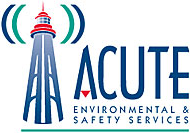In this article, we will discuss the importance of asbestos removal and why you need asbestos removal training.
Asbestos is a group of six naturally occurring fibrous minerals. Exposure to asbestos causes several cancers and diseases, which is why asbestos removal training is so important. The experts at ACUTE will train you on how to remove these dangerous materials – contact us today to sign up.
Now let’s dig in and discuss asbestos, what it is, why it’s important to have it removed, and why you need asbestos removal training to accomplish the task.
What Is Asbestos Removal and Why Do I Need Asbestos Removal Training?
Why is asbestos removal important?
Asbestos removal is also known as asbestos abatement. Asbestos is a friable material, meaning when it’s dry, it can be crumbled, pulverized, or powdered. Small fibres or clumps of fibres can be released into the air as dust, and inhaling asbestos during its manufacturing or use leads to major health concerns.
ACUTE’s asbestos removal training is designed for individuals in maintenance, general construction and property development who are involved in Type 1 and 2 abatement projects. These projects include Emergency Clean-up, Removal and Replacement of Asbestos Containing Ceiling Tiles, Minor Asbestos Removals, Cutting and Drilling of Asbestos-Containing Plaster and Drywall.
Learn about the major impact that asbestos can have
There are no significant health risks if the materials containing asbestos in your home or work are:
- Tightly bound in the original product, and it is in good condition
- Sealed behind walls and floorboards
- Isolated in the attic
- Left undisturbed
However, human health effects from long-term asbestos exposure are well documented. All forms of asbestos have been shown to cause lung cancer and mesothelioma.

Asbestos removal training is important because of major health risks associated with the material
Why do I need asbestos removal training?
In short, because the law requires it.
Due to the dangerous nature of asbestos, removal is not a DIY project. In fact, in some areas of the world, asbestos removal conducted by untrained personnel is illegal!
Asbestos removal training is broken up into three types:
-
-
- 1 to 10 square feet
- 11 to 100 square feet
- 100+ square feet
-
According to Ontario law, employers must ensure training in the following subjects is provided by a competent person to every worker working in a Type 1, Type 2 or Type 3 operation:
-
-
- The hazards of asbestos exposure.
- Personal hygiene and work practices.
- The use, cleaning and disposal of respirators and protective clothing.
-
What you will learn:
Asbestos removal training topics include:
-
-
- Regulatory requirements
- Asbestos identification
- Historical asbestos usage
- Sampling techniques
- Hazards and controls
- Personal Protective Equipment
- Measures and procedures associated with Type 1 and 2 asbestos operations
-
This is a one-day course (8 hours) that can be conducted at your facility or at our own training facility. There are some great benefits to both approaches. By completing your training on-site, we can save your staff travel time. However, by completing your training at our facility, you can benefit from our spacious training room, our state of the art hands-on training space, and full use of our break room.
More about asbestos
Asbestos is the generic name for six different naturally-occurring fibrous minerals. Based on their physical and chemical properties, there are two major groups of asbestos: serpentine and amphibole, according to the Canadian Centre For Occupational Health and Safety.
-
-
- Serpentine: Serpentine fibres are long, flexible, curved and can be woven together. The main type of serpentine asbestos is chrysotile (white asbestos), which is the main type of asbestos used in manufacturing.
- Amphibole: Amphibole fibres are straight and stiff. They are generally brittle and rod or needle-shaped, which limits commercial usefulness.
-
Back in the 1960s, almost 40% of the world’s asbestos production was concentrated in a narrow area in southern Quebec known as the “Serpentine Belt.”
In 2016, the federal government of Canada announced a commitment to ban asbestos and asbestos-containing products by 2018.

Asbestos has not been mined in Canada since 2012
Where and why has asbestos been used?
Asbestos possesses heat-resistant and insulating properties. Furthermore, asbestos does not dissolve in water or evaporate. These properties mean that asbestos fibres do not burn, do not undergo significant reactions with most chemicals, and do not break down significantly in the environment.
Asbestos was therefore used in a wide range of products. Before 1990, it’s main use was insulating buildings and homes against cold weather and noise, and used as fireproofing. Asbestos was additionally used by industrial, construction, and commercial sectors in products such as:
-
-
- Building materials (roofing shingles, roof sealants, ceiling and floor tiles, paper products and felts, house siding, and asbestos-containing cement and plaster products)
- Friction materials (automobile clutch pads, brake linings, pads and shoes, and transmission parts)
- Fire and heat protection wear
- Industrial furnaces and heating systems
- Heat, electrical, and sound insulation or wrappings
- Insulation for hot and cold areas
- Packing materials, gaskets, linings, and coatings
-

Asbestos was commonly used in asphalt road surfacing
Trust ACUTE For Asbestos Removal Training
You can trust ACUTE to provide you with the best comprehensive, hands-on training. Here are some ways that ACUTE goes beyond government compliance in Ontario health and safety training:
-
-
- Open Door Instructor-Student Partnership: ACUTE’s training services emphasize client participation. Staff foster relationships with clients and serve as a touchstone for advice moving forward.
- Serving Your Team and Industry: With a vast array of clients in the manufacturing, construction, health, academic, and government sectors, ACUTE brings the best safety practices from across the spectrum to your workplace.
- 100 Years of Combined Experience: ACUTE provides comprehensive health and safety training, on-site safety services, and consulting services. With over 100 years of combined experience, our staff offers more than theoretical or abstract ideas. ACUTE offers solutions.
- Track Record of Success: ACUTE is rated 4.9/5 stars on Google reviews, demonstrating a commitment to our clients, quality, and a passion for training.
-
“For over 20 years, Ron Campbell and the professional team at Acute has helped us develop a continuously improving safety program customized to our unique needs in environmental testing and renewable energy services. We are proud of our safety culture and record supported by Acute training services.”
– Hank, Environmental Consulting Company. Read more customer reviews here.
Contact us today for quality training in your workplace or on-site at ACUTE’s proven training facilities!

For all OABA members, please contact the ACUTE office prior to registration


